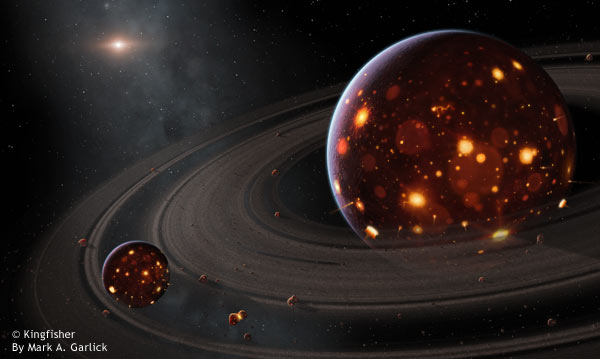“When you’re finally up at the moon looking back on earth, all those differences and nationalistic traits are pretty well going to blend, and you’re going to get a concept that maybe this really is one world and why the hell can’t we learn to live together like decent people.” -Frank Borman, Apollo 8
You've got to wonder about the Moon. I'm not talking about what it looks like or what it has to teach us about Earth, but why the far side of the Moon looks so different from the side that faces us?
For the past 55 years, we've known that the far side looks so very different from the near side, but we weren't able to figure out why. Well, thanks to Scienceblogs' very own Steinn Sigurdsson and his collaborators, it looks like we now have the solution!
 Image credit: copyright Kingfisher, art by Mark A. Garlick, retrieved from http://spaceart1.ning.com/photo/birth-of-the-moon.
Image credit: copyright Kingfisher, art by Mark A. Garlick, retrieved from http://spaceart1.ning.com/photo/birth-of-the-moon.


[1] At what distance from the Earth did the the Moon form? [I read somewhere the Moon appeared 10 times bigger, but the above space art picture appears to show the moon orbiting much closer than that ~ about one Earth diameter above the Earth surface]
[2] Did we calculate the figure for [1] from best guesses or is there physical evidence?
[3] How quickly would tidal lock occur at that distance? [my wild guess is 100M years]
[4] Does tidal locking occur quicker when both bodies are still molten & thus more "squidgy"?
@ Micael
will try to point you to an answer for 1&2:
Age of the moon is thought to be around 4.5 bill. years (wiki). Evidence as i understand comes mostly from geology.
Tidal drift and distance today can be measured directly with laser ranging and retreat today is 3.8 cm/year. Based on paleonthological and geoological evidence for tides, it was estimated that the retreat during 2.5 bill - 650 miilion years was around 1.3 cm/year. So given the distance and drift today, and average recession in the past, you can roughly quickly calculate how close it was when it formed.... (answer to 2.)
If looking really roughly... let's take 2cm/year as an average for total life. 4.5 billion years x 2cm = 9 bill cm or 90.000km
90.000 km closer than today would be a rough answer to your (1). Visually looking from earth it would be maybe 15-20% bigger, but not 2000% bigger like in some "artistic" renders.
hope this helps
Ever consider the possibility the skin of the (early) moon may have migrated to the far side due to Centrifugal force?
> the Earth-Moon distance is some forty times larger
> than the diameter of the Earth?
Which number have I gotten approximately wrong?
8000? 240,000?
@Hank #3: Neither one. The average Earth-Moon distance is almost exactly 30 times Earth's diameter, not 40 times as Ethan wrote.
@ Hank & Michael
Michael is correct in terms of size, but both numbers @4 are wrong
- diameter 12.700 km, distance 384.000 km
ahh.. sorry.. just realized.. you were talking in miles... my bad.
Irony is dead ....
Hi, Ethan. Thanks for writing up our work!
One correction: the maria formed much later than the Moon — as long as 1 billion years it and the Earth had cooled. They filled impact basins that also formed long after the events described in our paper.
Rather, our model assumes that the maria had an easier time forming on the nearside where the crust is significantly thinner. We hypothesize that the reason for the thinner crust on the nearside is that there were fewer crust-forming elements on the nearside during most of the crust formation, which also occurred long after the Earth and Moon's surface had cooled.
All the action in our model that occurs when the Earth is still hot involves how the crust-forming minerals made their way into the Lunar Magma Ocean in the first place. We hypothesize that the farside of the Moon was in shadow, and so the refractory elements calcium and aluminum preferentially condensed there. Once there, they were incorporated into the magma ocean, and much later helped form the thicker crust.
Much later, impacts formed the basins and finally, later still, basalts erupted and formed the maria on the nearside because they could more easily penetrate the thinner crust there.
I would prefer a more scientific straight-forward style of writing. For example, giving up the answer straight away. It's just easier to read and comprehend. The unfolding narrative, the questions, the wrong answers, and finally the right answer makes a good bed time story, but in a real world, little time context, sorry. It's indulgent. Just deliver the goods.
Given the distance I doubt the Earth's heat could have this effect. There is another recent interesting theory here: http://www.space.com/12529-earth-2-moons-collision-moon-formation.html
@ Michael Fischer
actually tonight (Sunday, 13th) is "Super Moon", the closest Moon is in it's orbit to us. And is what you would actually see some 2 billion years ago, when moon was some 50.000km closer ;) Pretty cool for science, but a letdown in size, you will hardly notice any difference :)
Thesis is: Earth provided a kind of blanket on the near side, the other side was exposed like an uncovered behind so it cooled off quicker.
Good thinking.
Was the whole Moon molten after the collision with Earth? It would have endured the greatest insult, leaving the other half, less crumpled. Maybe the Earth contact side depicts a scab
Nice mental images but hard to select a true explanation without more evidence.